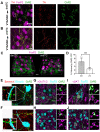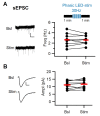Midbrain dopaminergic inputs gate amygdala intercalated cell clusters by distinct and cooperative mechanisms in male mice
- PMID: 34028352
- PMCID: PMC8143799
- DOI: 10.7554/eLife.63708
Midbrain dopaminergic inputs gate amygdala intercalated cell clusters by distinct and cooperative mechanisms in male mice
Abstract
Dopaminergic signaling plays an important role in associative learning, including fear and extinction learning. Dopaminergic midbrain neurons encode prediction error-like signals when threats differ from expectations. Within the amygdala, GABAergic intercalated cell (ITC) clusters receive one of the densest dopaminergic projections, but their physiological consequences are incompletely understood. ITCs are important for fear extinction, a function thought to be supported by activation of ventromedial ITCs that inhibit central amygdala fear output. In mice, we reveal two distinct novel mechanisms by which mesencephalic dopaminergic afferents control ITCs. Firstly, they co-release GABA to mediate rapid, direct inhibition. Secondly, dopamine suppresses inhibitory interactions between distinct ITC clusters via presynaptic D1 receptors. Early extinction training augments both GABA co-release onto dorsomedial ITCs and dopamine-mediated suppression of dorso- to ventromedial inhibition between ITC clusters. These findings provide novel insights into dopaminergic mechanisms shaping the activity balance between distinct ITC clusters that could support their opposing roles in fear behavior.
Keywords: GABA; amygdala; corelease; dopamine; extinction; intercalated neurons; mouse; neuroscience.
© 2021, Aksoy-Aksel et al.
Conflict of interest statement
AA, AG, AS, FF, IE No competing interests declared
Figures

























Similar articles
-
Functional connectivity of the main intercalated nucleus of the mouse amygdala.J Physiol. 2011 Apr 15;589(Pt 8):1911-25. doi: 10.1113/jphysiol.2010.201475. Epub 2011 Jan 10. J Physiol. 2011. PMID: 21224220 Free PMC article.
-
Dousing the flames of fear.J Physiol. 2011 Apr 15;589(Pt 8):1865. doi: 10.1113/jphysiol.2011.206920. J Physiol. 2011. PMID: 21498379 Free PMC article. No abstract available.
-
A specialized subclass of interneurons mediates dopaminergic facilitation of amygdala function.Neuron. 2005 Dec 22;48(6):1025-37. doi: 10.1016/j.neuron.2005.10.029. Neuron. 2005. PMID: 16364905
-
GABAergic neurons: gate masters of the amygdala, mastered by dopamine.Neuron. 2005 Dec 22;48(6):877-9. doi: 10.1016/j.neuron.2005.12.002. Neuron. 2005. PMID: 16364892 Review.
-
65 years of research on dopamine's role in classical fear conditioning and extinction: A systematic review.Eur J Neurosci. 2024 Mar;59(6):1099-1140. doi: 10.1111/ejn.16157. Epub 2023 Oct 17. Eur J Neurosci. 2024. PMID: 37848184
Cited by
-
Amygdala Intercalated Cells: Gate Keepers and Conveyors of Internal State to the Circuits of Emotion.J Neurosci. 2022 Dec 7;42(49):9098-9109. doi: 10.1523/JNEUROSCI.1176-22.2022. J Neurosci. 2022. PMID: 36639901 Free PMC article. Review.
-
Dopamine release and dopamine-related gene expression in the amygdala are modulated by the gastrin-releasing peptide in opposite directions during stress-enhanced fear learning and extinction.Mol Psychiatry. 2025 Jun;30(6):2381-2394. doi: 10.1038/s41380-024-02843-8. Epub 2024 Nov 23. Mol Psychiatry. 2025. PMID: 39580604 Free PMC article.
-
Dopaminergic circuits underlying associative aversive learning.Front Behav Neurosci. 2022 Nov 10;16:1041929. doi: 10.3389/fnbeh.2022.1041929. eCollection 2022. Front Behav Neurosci. 2022. PMID: 36439963 Free PMC article. Review.
-
Molecular and cellular evolution of the amygdala across species analyzed by single-nucleus transcriptome profiling.Cell Discov. 2023 Feb 14;9(1):19. doi: 10.1038/s41421-022-00506-y. Cell Discov. 2023. PMID: 36788214 Free PMC article.
-
L-DOPA modulates activity in the vmPFC, nucleus accumbens, and VTA during threat extinction learning in humans.Elife. 2021 Sep 2;10:e65280. doi: 10.7554/eLife.65280. Elife. 2021. PMID: 34473055 Free PMC article.
References
Publication types
MeSH terms
Substances
Associated data
Grants and funding
LinkOut - more resources
Full Text Sources
Other Literature Sources
Molecular Biology Databases

